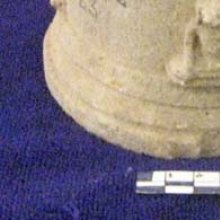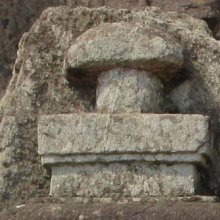Circular: 2 definitions
Introduction:
Circular means something in Hinduism, Sanskrit. If you want to know the exact meaning, history, etymology or English translation of this term then check out the descriptions on this page. Add your comment or reference to a book if you want to contribute to this summary article.
Images (photo gallery)
(+52 more images available)
In Hinduism
Natyashastra (theatrics and dramaturgy)
Source: Shodhganga: Elements of Art and Architecture in the Trtiyakhanda of the Visnudharmottarapurana (natya)Circular Movement is associated with Vivartita: one of the “five kinds of side-movements” (in Sanskrit Dramas), as conveyed through Āṅgikābhinaya: one of the four divisions of Abhinaya or “ways to convey or represent one’s emotion to others”, according to the Nāṭyaśāstra and the Viṣṇudharmottarapurāṇa, an ancient Sanskrit text which (being encyclopedic in nature) deals with a variety of cultural topics such as arts, architecture, music, grammar and astronomy.—The āṅgikābhinaya includes the histrionic representation of the limbs which is simply known as physical gestures. There are five kinds of side movements accepted in the Viṣṇudharmottarapurāṇa. The vivartita movement refers to circular movement.

Natyashastra (नाट्यशास्त्र, nāṭyaśāstra) refers to both the ancient Indian tradition (shastra) of performing arts, (natya—theatrics, drama, dance, music), as well as the name of a Sanskrit work dealing with these subjects. It also teaches the rules for composing Dramatic plays (nataka), construction and performance of Theater, and Poetic works (kavya).
Vastushastra (architecture)
Source: Shodhganga: Elements of Art and Architecture in the Trtiyakhanda of the Visnudharmottarapurana (vastu)Circular or Round-shaped Temples (in ancient Indian architecture) are described in literature such as the Viṣṇudharmottarapurāṇa, an ancient Sanskrit text which (being encyclopedic in nature) deals with a variety of cultural topics such as arts, architecture, music, grammar and astronomy.—Temples like saumudga, nandī, vṛtta, vṛṣa etc. were constructed in circular or round shape. According to Viṣṇudharmottarapurāṇa, the kaṭi i.e., waist part and the mekhalā i.e., the slop of the digvandha type of temple should be made in circular shape. Ānanda type of temple should be constructed in square or circular shape.

Vastushastra (वास्तुशास्त्र, vāstuśāstra) refers to the ancient Indian science (shastra) of architecture (vastu), dealing with topics such architecture, sculpture, town-building, fort building and various other constructions. Vastu also deals with the philosophy of the architectural relation with the cosmic universe.
See also (Relevant definitions)
Starts with: Circular stone.
Full-text (+791): Parimandala, Cakravyuha, Vartula, Cakrakara, Mandala, Cakkala, Vatin, Cakra, Rasakrida, Cakadala, Vatahukuma, Nayata, Cabuka, Mandalita, Vrittakara, Parimandalita, Caki, Praskunda, Mandalamala, Pitali.
Relevant text
Search found 174 books and stories containing Circular; (plurals include: Circulars). You can also click to the full overview containing English textual excerpts. Below are direct links for the most relevant articles:
Yoga Vasistha [English], Volume 1-4 (by Vihari-Lala Mitra)
Chapter LI - Description of sindhu’s dominions < [Book III - Utpatti khanda (utpatti khanda)]
Chapter LXXXIX - The parable of an elephant < [Book VI - Nirvana prakarana part 1 (nirvana prakarana)]
Chapter VII - The nominal meanings of om < [The om tat sat]
Our ‘Rao Sahib’ < [January 1953]
The Enigmatic Monument < [July – September, 1990]
Batukamma < [April – June, 2003]
Stupas in Orissa (Study) (by Meenakshi Chauley)
Minor Votive Stupas at Lalitagiri < [Chapter 4]
Minor Votive Stupas at Udayagiri < [Chapter 4]
Minor Votive Stupas at Langudi < [Chapter 4]
Pallava period (Social and Cultural History) (by S. Krishnamurthy)
Head-dress of Women (b): Cylindrica cap like Makuta < [Chapter 4 - Material Culture of the People]
Head-dress of Men (Tiara) < [Chapter 4 - Material Culture of the People]
Crowns for Men (b): Karanda-makuta < [Chapter 4 - Material Culture of the People]
The Garuda Purana (by Manmatha Nath Dutt)
Chapter XLV - Characteristic marks of Shalagrama Stones (Shaligram) < [Agastya Samhita]
Chapter XXVI - The mode of performing the rites of Karanyasa < [Agastya Samhita]
Chapter VIII - Description of the mode of worshipping Vishnu < [Agastya Samhita]
Nitiprakasika (Critical Analysis) (by S. Anusha)
Related products
(+101 more products available)











